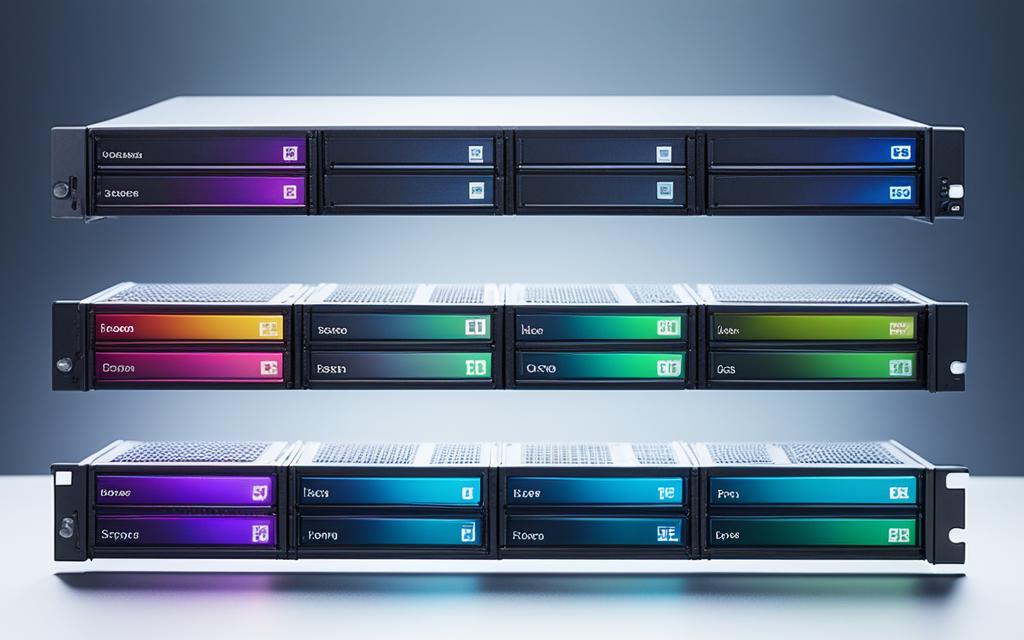Table of Contents
The hierarchy of computer storage is crucial for making data processing and system performance better. It helps us see how different storage types work together to improve efficiency. The structure starts with very fast CPU registers and goes down to common storage options.
Each level has a unique role, highlighting the need to balance speed, capacity, and cost in computer memory systems. With advances in technology, having a good storage hierarchy is more important. It changes the way we handle and get to data.
We find that both access time and cost per bit go up as you go deeper into the storage layers. This shows the importance of smart data management. For anyone wanting to really understand data storage today, getting this structure is essential. It affects how systems perform in different areas12.
Key Takeaways
- The memory hierarchy improves data access speeds and overall system performance.
- Each level of storage has distinct characteristics, impacting speed and cost.
- Understanding memory types is crucial for efficient data management.
- Access times vary significantly from fast registers to slower tertiary storage.
- The capacity of storage increases as one moves down the memory hierarchy.
Understanding Computer Storage Types
Today’s digital world has different systems for managing data. We break these into three types: primary storage, secondary devices, and tertiary systems. This helps organisations boost their performance and keep information accessible.
Primary Storage
Primary storage is vital for making computers run fast. It mostly includes RAM, which varies from a few gigabytes to terabytes. This makes it quicker than devices like HDDs or SSDs. But, it’s volatile, so if power is lost, so is the data.
Secondary Storage
Secondary storage devices, like HDDs and SSDs, keep data safe over the long term. HDDs hold data in sectors, now evolving to larger sizes. SSDs, on the other hand, are faster because they use NAND flash memory to store information. They are cheaper per bit than primary storage, making them popular for saving large amounts of data3.
Tertiary Storage
Tertiary storage adds another level to data management. It includes things like magnetic tapes and cloud services. These are mainly for storing old data. They’re cheap and can hold a lot, which is great for organisations needing to keep data for a long time. They help follow laws and get to data when needed.
| Storage Type | Characteristics | Use Cases |
|---|---|---|
| Primary Storage | Volatile, fast, measured in GB to TB | Running applications, active data processing |
| Secondary Storage | Non-volatile, larger capacity, slower than primary | Data backup, system storage |
| Tertiary Storage | Cost-effective, slow access time | Data archiving, long-term storage solutions |
The Importance of Memory Hierarchy
The memory hierarchy significance in computer architecture is crucial for enhancing processing speed. It ranks storage types by their speed, capacity, and cost, cutting down data access times. By structuring memory in levels like registers, cache memory, and secondary storage, delays in data retrieval and processing decrease. This boosts the system’s overall performance. Without this hierarchy, systems might face high costs or slow speeds. It’s vital for computer engineers to design systems with these principles in mind45.
Registers are the fastest type of memory, directly processing current tasks. They hold data in use, allowing quick access times critical for programs to run smoothly. Cache memory acts as a mid-point between the processor and main memory. It stores data that’s often accessed, speeding up processing5. Main memory, or RAM, holds data in active use or soon to be accessed. Secondary storage keeps data that’s not currently needed but is important for long-term use46.
The principle of locality improves system performance by focusing on frequently used data. By giving priority to this data in faster memory levels, computers work more efficiently and reduce access times. Managing the costs of different memory types helps ensure fast memory benefits critical operations without extra expenses5. A well-structured memory hierarchy not only boosts performance optimisation. It also reduces power consumption. This happens because it accesses lower-level memory effectively when needed, saving system resources6.
| Memory Type | Speed | Cost | Capacity |
|---|---|---|---|
| Registers | Fastest | Highest | Smallest |
| Cache Memory | Very Fast | High | Small |
| Main Memory (RAM) | Fast | Moderate | Moderate |
| Secondary Storage | Slow | Lowest | Largest |
Components of the Hierarchy of Computer Storage
It’s important to know about the parts of computer storage to make your system work better and faster. These parts include registers, cache memory, main memory, and secondary storage. Each plays a unique role in storing and getting data to the processor quickly.
Registers
Registers are the quickest type of storage, found right inside the CPU. They keep data for a short time to make processing faster, which helps lower wait times. Without this quick system, your computer would slow down because it takes longer to get data from the main memory7. Registers work so fast that getting data from them is almost instant, helping your computer do tasks quickly.
Cache Memory
Cache memory comes after registers and is key in making data access quicker between registers and main memory. It is sorted into levels, with Level 1 being the quickest and nearest to the CPU. Processors with many cores share cache memory, which makes getting data even faster7. Using cache efficiently means your computer can get to often-used data and instructions quicker.
Main Memory
Main memory includes RAM and ROM and is the main place for storing data. It’s bigger but slower than registers and cache. As we move down the hierarchy, it takes longer to get data but there’s more space available7. It’s vital for keeping active data and programs ready so the CPU can get them without much wait.
Secondary Storage Devices
Then, we have secondary storage devices for data you’re not using right then. This tier is filled with HDDs and SSDs, each offering different benefits for storage cost and speed. HDDs are cheaper, but SSDs work faster8. However, getting data from these devices takes longer than from main memory7. Secondary storage is crucial for keeping lots of data safely and for a long time, making it a bridge between temporary and more lasting storage solutions.
| Component | Speed | Capacity | Cost |
|---|---|---|---|
| Registers | Fastest | Lowest | Highest per bit |
| Cache Memory | Very Fast | Low to Moderate | High per bit |
| Main Memory | Fast | Moderate | Moderate per bit |
| Secondary Storage | Slow | High | Lowest per bit |
Performance Metrics in Storage Hierarchy
The performance of computer storage systems is gauged by key metrics. These are crucial for their operation’s success. They help decide the best storage options by looking at access time, capacity, and cost.
Access Time
Access time is crucial in the storage hierarchy. It’s the time to read or write data. For instance, in top systems like Intel Haswell Mobile, speed varies across memory levels. L1 cache reaches speeds up to 700 GB/s, L2 at 200 GB/s, L3 at 100 GB/s, and L4 at 40 GB/s9. Knowing these speeds helps improve system efficiency, lower latency, and better user experience.
Capacity
Capacity is key in computer systems. It affects how much data you can store and influences memory choice. The memory hierarchy includes things like cache and registers, up to RAM, secondary storage, and off-line storage. Matching storage levels’ capacity with technology needs is essential910.
Cost Per Bit
Keeping costs low is crucial for organisations storing lots of data. Finding the right balance between cost per bit and performance is essential. By choosing high-capacity yet affordable solutions, businesses can avoid extra expenses. As storage gets complex, it’s important to keep cost efficiency in mind without compromising performance10.
| Memory Level | Access Speed (GB/s) | Storage Capacity | Cost Efficiency |
|---|---|---|---|
| L1 Cache | 700 | Low | High |
| L2 Cache | 200 | Low | High |
| L3 Cache | 100 | Medium | Medium |
| RAM | – | High | Low |
| Secondary Storage | – | Very High | Medium |
The Evolution of Storage Technologies
Data storage has changed a lot, always looking for better speed and efficiency. This journey in storage technology evolution is all about finding new ways to store our data.
From Magnetic Tapes to SSDs
Magnetic tapes were once the main way to store data because they could hold a lot but were cheap. Yet, they were slow to access data. With time, solid-state drives (SSDs) came along and changed everything. SSDs use flash memory and are ten times faster than old hard drives. This made SSDs the best choice for quick data access11.
The move from magnetic tapes to SSDs has brought big improvements. Early computers had very little memory and were slow. Now, there’s a huge choice of storage devices that are fast and cheaper per bit of data12.
Future Trends in Storage Solutions
Future storage looks exciting with new memory tech like STT-MRAM. It’s all about being faster and more efficient and could take on today’s DRAM11. New memory tech aims to speed up access and handle more data than ever.
As the world’s data needs grow, combining different types of storage will be key. We expect big changes in how fast and reliably we can store and access data12.
Characteristics of a Well-Designed Memory Hierarchy
A well-designed memory system is essential for boosting how fast a computer works by making sure data can be quickly found at different memory levels. It splits into internal memory (like Registers, Cache, and RAM) and external memory (such as Magnetic and Optical Disks)13. Registers are at the top. They are the quickest, with access in about 1ns and can hold data from 32-bit to 64-bit14. Cache Memory uses SRAM and gets data in about 10ns since it’s right on the CPU14.
Moving down, the time it takes to access data increases. DRAM, used for main memory, has access times around 100ns14. External memory has more space but is slower. For instance, accessing data on Magnetic Tapes can take about 100ms14. This structured design not only speeds up access but also makes resource use more efficient. Costs per bit go up from the bottom to the top of the hierarchy13.
Stats show that advanced microprocessors can have more than 10 MB of cache on-chip. For example, Intel Core i7s can handle 409.6 GB/s. That’s far more than the 25 GB/s of DRAM15. The system works better thanks to different RAM types, like SRAM and DRAM, each serving specific purposes13.
The following table encapsulates the key characteristics of the memory types typically employed within a well-designed memory hierarchy:
| Memory Type | Access Time | Capacity | Cost per Bit |
|---|---|---|---|
| Registers | ~1 ns | 32-64 bits | Highest |
| Cache Memory (SRAM) | ~10 ns | KBs – MBs | High |
| Main Memory (DRAM) | ~100 ns | GBs | Moderate |
| Flash Memory | ~1 µs | GBs | Low |
| Magnetic Disks | ~10 ms | GBs-TBs | Low |
| Magnetic Tapes | ~100 ms | PBs | Lowest |
The layout of the memory hierarchy is key in getting the right balance of speed, space, and cost. This makes sure the system works a lot better13
Conclusion
Understanding how computer storage works is key to better data handling and boosting system speed. This structure is made up of levels, from registers and cache to main memory. Then it goes down to HDDs and SSDs for bigger storage. Each part is vital for fast data fetch and balancing between speed and space, making sure important data is quick to access while keeping lots of info in slower memory56.
The setup of memory hierarchy is crucial due to its effects on energy use and saving money. By using fast memory for important tasks, systems use less power and save costs on bulk storage. New storage tech keeps making these systems better, offering custom solutions for various needs. This is key as we always want more speed and storage567.
In short, knowing these basic ideas improves how we manage digital data and sets the base for new storage technologies. As we move deeper into a world filled with data, how memory is arranged will play a big part in new tech breakthroughs and keeping our computers fast56.
FAQ
What is the hierarchy of computer storage?
The hierarchy of computer storage organises different types of storage. They are sorted by their speed, capacity, and cost. This helps in quick data access and better system performance.
What are the three main types of computer storage?
The three key types of computer storage are primary storage, like RAM; secondary storage, such as hard drives; and tertiary storage, including optical discs. Each type serves unique roles in the storage system.
Why is memory hierarchy significant in computer systems?
The significance of memory hierarchy comes from its efficient storage arrangement. It speeds up data access. Therefore, it boosts system performance and quick access to frequently used data.
What components are included in the memory hierarchy?
The memory hierarchy includes registers, cache memory, main memory (RAM), and secondary storage devices. Every component is vital for efficient data management and quick retrieval.
What performance metrics are important in the storage hierarchy?
In the storage hierarchy, key performance metrics are access time, storage capacity, and cost per bit. These metrics help assess different storage options’ efficiency and value.
How has storage technology evolved over the years?
Storage technology has greatly evolved, moving from magnetic tapes to solid-state drives (SSDs). Innovations continue to emerge, offering faster and more reliable storage options.
What characteristics define a well-structured memory hierarchy?
A well-structured memory hierarchy ensures efficient data retrieval and minimal access times. It enhances system performance. Cost efficiency is also a vital consideration.
Source Links
- https://www.geeksforgeeks.org/memory-hierarchy-design-and-its-characteristics/ – Memory Hierarchy Design and its Characteristics – GeeksforGeeks
- https://www.techtarget.com/whatis/definition/hierarchy – What is hierarchy (memory hierarchy)?
- https://www.techtarget.com/searchstorage/definition/storage – What is computer storage and how is it used?
- https://www.tutorchase.com/answers/ib/computer-science/why-is-the-memory-hierarchy-important-in-computer-architecture – Why is the memory hierarchy important in computer architecture? | TutorChase
- https://www.almabetter.com/bytes/articles/what-is-memory-hierarchy – What is Memory Hierarchy? Design and Characteristics
- https://www.shiksha.com/online-courses/articles/memory-hierarchy-in-operating-system/ – Memory Hierarchy in Operating System – Shiksha Online
- https://byjus.com/gate/design-and-characteristics-of-memory-hierarchy-notes/ – Design and Characteristics of Memory Hierarchy | GATE Notes
- https://www.sciencedirect.com/topics/computer-science/storage-hierarchy – Storage Hierarchy – an overview
- https://en.wikipedia.org/wiki/Memory_hierarchy – Memory hierarchy
- https://www.geeksforgeeks.org/computer-organization-performance-of-computer/ – Performance of Computer in Computer Organization – GeeksforGeeks
- https://spear-itn.eu/memory-hierarchy-how-does-computer-memory-work/ – Memory Hierarchy – How does computer memory work ? – SPEAR ITN
- https://www.geeksforgeeks.org/storage-structure-in-operating-systems/ – Storage Structure in Operating Systems – GeeksforGeeks
- https://annamalaiuniversity.ac.in/studport/download/engg/it/resources/Unit-IV & V Course Material.pdf – PDF
- https://www.scaler.com/topics/memory-hierarchy/ – Memory Hierarchy Design and Characteristics – Scaler Topics
- https://www.cs.umd.edu/~meesh/411/CA-online/chapter/memory-hierarchy-design-basics/index.html – 21 Memory Hierarchy Design – Basics








